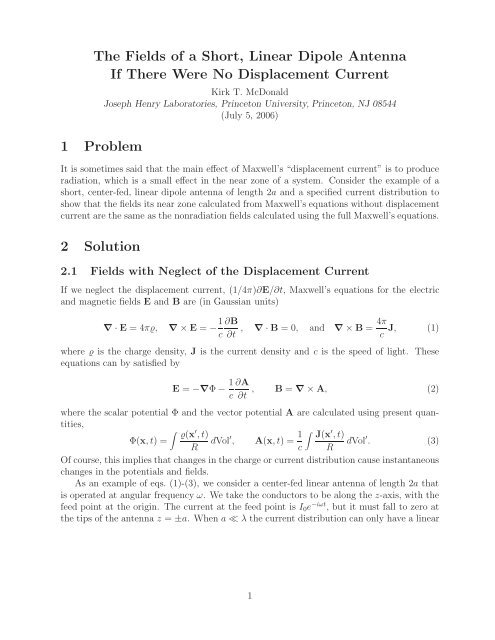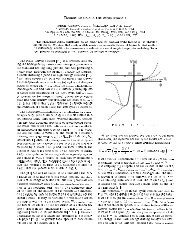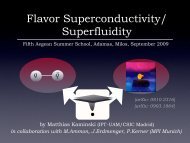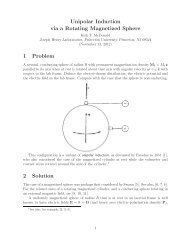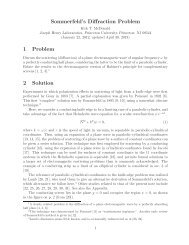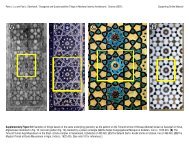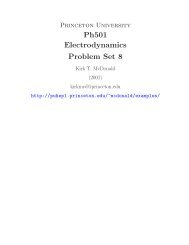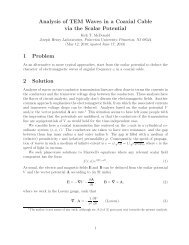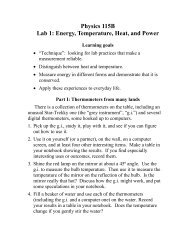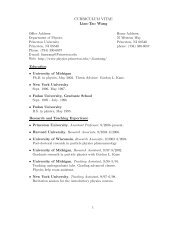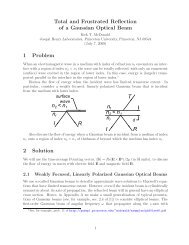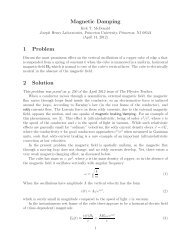The Fields of a Short, Linear Dipole Antenna If There Were No ...
The Fields of a Short, Linear Dipole Antenna If There Were No ...
The Fields of a Short, Linear Dipole Antenna If There Were No ...
You also want an ePaper? Increase the reach of your titles
YUMPU automatically turns print PDFs into web optimized ePapers that Google loves.
<strong>The</strong> <strong>Fields</strong> <strong>of</strong> a <strong>Short</strong>, <strong>Linear</strong> <strong>Dipole</strong> <strong>Antenna</strong><br />
<strong>If</strong> <strong>The</strong>re <strong>Were</strong> <strong>No</strong> Displacement Current<br />
1 Problem<br />
Kirk T. McDonald<br />
Joseph Henry Laboratories, Princeton University, Princeton, NJ 08544<br />
(July 5, 2006)<br />
It is sometimes said that the main effect <strong>of</strong> Maxwell’s “displacement current” is to produce<br />
radiation, which is a small effect in the near zone <strong>of</strong> a system. Consider the example <strong>of</strong> a<br />
short, center-fed, linear dipole antenna <strong>of</strong> length 2a and a specified current distribution to<br />
show that the fields its near zone calculated from Maxwell’s equations without displacement<br />
current are the same as the nonradiation fields calculated using the full Maxwell’s equations.<br />
2 Solution<br />
2.1 <strong>Fields</strong> with Neglect <strong>of</strong> the Displacement Current<br />
<strong>If</strong> we neglect the displacement current, (1/4π)∂E/∂t, Maxwell’s equations for the electric<br />
and magnetic fields E and B are (in Gaussian units)<br />
∇ · E =4πϱ, ∇ × E = − 1 ∂B<br />
c ∂t , ∇ · B =0, and ∇ × B = 4π J, (1)<br />
c<br />
where ϱ is the charge density, J is the current density and c is the speed <strong>of</strong> light. <strong>The</strong>se<br />
equations can by satisfied by<br />
E = −∇Φ − 1 ∂A<br />
, B = ∇ × A, (2)<br />
c ∂t<br />
where the scalar potential Φ and the vector potential A are calculated using present quantities,<br />
∫ ϱ(x ′ ,t)<br />
Φ(x,t)=<br />
R dVol′ , A(x,t)= 1 ∫ J(x ′ ,t)<br />
c R dVol′ . (3)<br />
Of course, this implies that changes in the charge or current distribution cause instantaneous<br />
changes in the potentials and fields.<br />
As an example <strong>of</strong> eqs. (1)-(3), we consider a center-fed linear antenna <strong>of</strong> length 2a that<br />
is operated at angular frequency ω. We take the conductors to be along the z-axis, with the<br />
feed point at the origin. <strong>The</strong> current at the feed point is I 0 e −iωt , but it must fall to zero at<br />
the tips <strong>of</strong> the antenna z = ±a. Whena ≪ λ the current distribution can only have a linear<br />
1
dependence on z, so its form must be 1<br />
I(|z|
Far from the antenna the potentials (6) and (7) simplify to the forms<br />
Φ ≈ I 0az<br />
sin(ωt), and A<br />
ckr0<br />
3 z ≈ I 0a<br />
cos(ωt), (9)<br />
cr 0<br />
where r 0 = √ ρ 2 + z 2 . <strong>The</strong> far-zone scalar potential is that <strong>of</strong> a dipole consisting <strong>of</strong> charges<br />
±iI 0 /ω separated by distance a, and the vector potential is that due to a length a <strong>of</strong> current<br />
I 0 , with both potentials oscillating at frequency ω.<br />
<strong>The</strong> magnetic field has only a φ component, and varies only as cos(ωt),<br />
B φ = − ∂A z<br />
∂ρ = ρI [<br />
0<br />
ca cos(ωt) 1<br />
r 1 − (z − a) + 1<br />
r 2 − (z + a) − 2 ]<br />
r 0 − z<br />
= I 0<br />
cρa (r 1 + r 2 − 2r 0 )cos(ωt) ≈ I 0a sin θ<br />
cos(ωt), (10)<br />
cr0<br />
2<br />
where the approximation holds for r 0 ≫ a, and the distances r 1 and r 2 are from the tips <strong>of</strong><br />
the antenna to the observation point, as shown in the figure below, where<br />
r0 2 = ρ2 + a 2 , r1 2 = ρ2 +(z − a) 2 , r2 2 = ρ2 +(z + a) 2 . (11)<br />
<strong>The</strong> ρ component <strong>of</strong> the electric field is<br />
E ρ = − ∂Φ<br />
∂ρ = − ρI [<br />
]<br />
0<br />
cka sin(ωt) 1<br />
r 1 (r 1 − (z − a)) + 1<br />
r 2 (r 2 − (z + a)) − 2<br />
r 0 (r 0 − z)<br />
= − I [<br />
0 z − a<br />
+ z + a − 2z ]<br />
sin(ωt) ≈ 3I 0a cos θ sin θ<br />
sin(ωt), (12)<br />
cρka r 1 r 2 r 0 ckr0<br />
3<br />
and the z component <strong>of</strong> the electric field is<br />
E z = − ∂Φ<br />
∂z − 1 ∂A z<br />
= I {<br />
0 1<br />
c ∂t cka sin(ωt) + 1 − 2 r 1 r 2 r 0<br />
−k 2 [r 1 + r 2 − 2r 0 +(z − a)ln(r 1 − z + a)+(z + a)ln(r 2 − z − a) − 2z ln(r 0 − z)] }<br />
≈<br />
I 0a<br />
ck<br />
( 3cos 2 θ − 1<br />
r 3 0<br />
+ k2<br />
r 0<br />
)<br />
sin(ωt), (13)<br />
3
where the approximation hold at large distances. <strong>The</strong> electric field varies only as sin(ωt).<br />
<strong>The</strong> components <strong>of</strong> the electric field in spherical coordinates for r 0 ≫ a are<br />
E r ≈ I 0a<br />
ck<br />
(<br />
2<br />
r 3 0<br />
− k2<br />
r 0<br />
)<br />
cos θ sin(ωt),<br />
E θ ≈ I 0a<br />
ck<br />
(<br />
1<br />
r 3 0<br />
+ k2<br />
r 0<br />
)<br />
sin θ sin(ωt). (14)<br />
For large r 0 the electric field, but not the magnetic field, has a term that falls <strong>of</strong>f as 1/r 0 .<br />
Since E and B are out <strong>of</strong> phase the time-average Poynting vector is zero, and there is<br />
no (time-average) transport <strong>of</strong> energy away from the source when displacement current is<br />
neglected.<br />
In the near zone, where kr j ≪ 1forj =0, 1, 2 the nonzero field components can be<br />
written<br />
B φ (kr j ≪ 1) = I 0<br />
cρa [r 1 + r 2 − 2r 0 ]cos(ωt), (15)<br />
E ρ (kr j ≪ 1) = − I [<br />
0 z − a<br />
+ z + a − 2z ]<br />
sin(ωt), (16)<br />
cρka<br />
r 0<br />
E z (kr j ≪ 1) ≈ I 0<br />
cka<br />
r 1<br />
r 2<br />
[ 1<br />
r 1<br />
+ 1 r 2<br />
− 2 r 0<br />
]<br />
sin(ωt). (17)<br />
2.2 Near <strong>Fields</strong> When Displacement Current Is Included<br />
This section follows sec. 2.3 <strong>of</strong> [1] as to the near fields <strong>of</strong> a linear dipole antenna <strong>of</strong> length<br />
2a, withanassumed current distribution<br />
sin[k(a −|z|)] cos ωt<br />
I(z,t) =I 0 , (18)<br />
sin ka<br />
which is normalized such that I(z =0)=I 0 cos ωt.<br />
<strong>The</strong> electric and magnetic fields can be calculated from the retarded vector potential,<br />
which has only a z-component in this example,<br />
A z (x,t)= 1 c<br />
∫ a<br />
−a<br />
dz ′ I(z ′ ,t ′ = t − R/c)<br />
R<br />
= I 0e −iωt<br />
c<br />
∫ a<br />
−a<br />
dz ′<br />
sin sin[k(a −|z ′ |)] eikR<br />
R , (19)<br />
where k =2π/λ = ω/c and R = |x − x ′ |. <strong>The</strong>n, the fields E and B are related by 2<br />
B = ∇ × A,<br />
and<br />
[ ] i ∂E<br />
kc ∂t = E = i ∇ × B. (20)<br />
k<br />
We evaluate the field components in a cylindrical coordinate system (ρ, φ, z) to find for<br />
a small antenna with ka ≪ 1,<br />
B ρ = 0, (21)<br />
2 We note that the sequence <strong>of</strong> calculations in eqs. (19) and (20) could be interpreted as implying that the<br />
conduction current I leads to the vector potential and the magnetic field, and then the curl <strong>of</strong> the magnetic<br />
field leads to the “displacement current” (1/4π)∂E/∂t.<br />
4
{ iI0 e −iωt [<br />
(<br />
B φ = −Re e ikr 1<br />
+ e ikr 2<br />
− 2e ikr 0<br />
1 − k2 a 2 )]}<br />
(22)<br />
cρka<br />
2<br />
= I [<br />
(<br />
0<br />
sin(kr 1 − ωt)+sin(kr 2 − ωt) − 2 1 − k2 a 2 )<br />
]<br />
sin(kr 0 − ωt) , (23)<br />
cρka<br />
2<br />
B z = 0, (24)<br />
{ iI0 e −iωt [ (z − a)e<br />
ikr 1<br />
E ρ = −Re<br />
+ (z + (<br />
a)eikr 2<br />
− 2 zeikr 0<br />
1 − k2 a 2 )]}<br />
(25)<br />
cρka r 1 r 2 r 0 2<br />
= I [<br />
0<br />
(z − a) sin(kr 1 − ωt)<br />
+(z + a) sin(kr (<br />
2 − ωt)<br />
− 2z 1 − k2 a 2 ) ]<br />
sin(kr0 − ωt)<br />
(26) ,<br />
cρka<br />
r 1<br />
r 2<br />
2 r 0<br />
E φ = 0, (27)<br />
{ iI0 e −iωt [ (<br />
e<br />
ikr 1<br />
E z = Re<br />
+ eikr 2<br />
− 2 eikr 0<br />
1 − k2 a 2 )]}<br />
(28)<br />
cka r 1 r 2 r 0 2<br />
= − I [<br />
0 sin(kr1 − ωt)<br />
+ sin(kr (<br />
2 − ωt)<br />
− 2 1 − k2 a 2 ) ]<br />
sin(kr0 − ωt)<br />
. (29)<br />
cka r 1<br />
r 2 2 r 0<br />
For completeness, we also display the field components in a spherical coordinate system<br />
(r, θ, φ), noting that ρ = r 0 sin θ,<br />
B r = 0, (30)<br />
B θ = 0, (31)<br />
{ iI0 e −iωt [<br />
(<br />
B φ = −Re e ikr 1<br />
+ e ikr 2<br />
− 2e ikr 0<br />
1 − k2 a 2 )] }<br />
sin θ<br />
(32)<br />
cr 0 ka<br />
2<br />
[<br />
(<br />
I 0<br />
= sin(kr 1 − ωt)+sin(kr 2 − ωt) − 2 1 − k2 a 2 )<br />
]<br />
sin(kr 0 − ωt) sin θ, (33)<br />
cr 0 ka<br />
2<br />
{ iaI0 e −iωt [ ]}<br />
e<br />
ikr 1<br />
E r = Re<br />
− eikr 2<br />
(34)<br />
cr 0 ka r 1 r 2<br />
= − I [<br />
0a sin(kr1 − ωt)<br />
− sin(kr ]<br />
2 − ωt)<br />
, (35)<br />
cr 0 ka r 1<br />
r 2<br />
{<br />
iI0 e −iωt [<br />
(r<br />
2<br />
E θ = −Re<br />
0 − az)e ikr 1<br />
+ (r2 0 + az)e ikr (<br />
2<br />
− 2r<br />
cr0ka 2 0 e ikr 0<br />
1 − k2 a 2 )]}<br />
(36)<br />
sin θ r 1 r 2 2<br />
[<br />
I 0<br />
=<br />
(r<br />
cr0ka 2 0 2 − az) sin(kr 1 − ωt)<br />
+(r0 2 + az) sin(kr 2 − ωt)<br />
sin θ<br />
r 1<br />
r 2<br />
(<br />
−2r 0 1 − k2 a 2 )<br />
]<br />
sin(kr 0 − ωt) . (37)<br />
2<br />
E φ = 0, (38)<br />
<strong>The</strong> radiation fields are most prominent in the far zone, where r = r 0 ≈ r 1 ≈ r 2 . In spherical<br />
coordinates the only nonzero components to the radiation fields are 3<br />
{ iI0 ka e i(kr }<br />
0−ωt)<br />
B φ = E θ = −Re<br />
sin θ = I 0a sin(kr 0 − ωt)<br />
sin θ. (39)<br />
c<br />
c r 0<br />
r 0<br />
3 Verification that eqs. (36) and (37) become eq. (39) in the far zone is a bit subtle. See [1].<br />
5
<strong>The</strong> radiation fields depend on the small quantity ka, which permits us to identify the<br />
radiation fields in the near zone, where they are only a small part <strong>of</strong> the total fields.<br />
Close to the antenna, where kr j ≪ 1wehavecos(kr j ) ≈ 1 and sin(kr j ) ≈ kr j for<br />
j =0, 1, 2. <strong>The</strong> nonzero field components (23), (26) and (29) in cylindrical coordinates<br />
simplify to the forms close to the antenna:<br />
B φ (kr j ≪ 1) ≈ I [<br />
0 r1 + r 2 − 2r 0<br />
cρ a<br />
[ z − a<br />
E ρ (kr j ≪ 1) ≈ − I 0<br />
+ z + a<br />
cρka r 1 r 2<br />
E z (kr j ≪ 1) ≈ I [<br />
0 1<br />
+ 1 − 2 (<br />
cka r 1 r 2 r 0<br />
]<br />
cos(ωt) − ka sin(ωt) , (40)<br />
− 2z<br />
r 0<br />
(<br />
1 − k2 a 2<br />
2<br />
1 − k2 a 2 )]<br />
sin(ωt), (41)<br />
2<br />
)]<br />
sin(ωt). (42)<br />
Close to the antenna all <strong>of</strong> the electric field varies as sin(ωt), and so is 90 ◦ out <strong>of</strong> phase with<br />
the drive current. <strong>The</strong> largest part <strong>of</strong> the magnetic field is in phase with the current, but<br />
the radiation part <strong>of</strong> the magnetic field (which varies as ka) is90 ◦ out <strong>of</strong> phase with the<br />
current, and is therefore in phase with the electric field. Furthermore, the radiation parts<br />
<strong>of</strong> the electric and magnetic field have very similar magnitudes close to the antenna, even<br />
though the total electric field is much larger than the total magnetic field here.<br />
Thus, the assumed current distribution (4) generates radiation fields in its near zone that<br />
are similar in character to the radiation fields in the far zone: E rad ≈ B rad in magnitude an<br />
phase, and directed at right angles to one another.<br />
<strong>The</strong> nonradiation (“reactive”) parts <strong>of</strong> the fields in the near zone are<br />
B φ (kr j ≪ 1, non rad) ≈ I 0<br />
cρa [r 1 + r 2 − 2r 0 ]cos(ωt), (43)<br />
E ρ (kr j ≪ 1, non rad) ≈ − I [<br />
0 z − a<br />
+ z + a − 2z ]<br />
sin(ωt), (44)<br />
cρka<br />
r 0<br />
E z (kr j ≪ 1, non rad) ≈ I 0<br />
cka<br />
r 1<br />
r 2<br />
[ 1<br />
r 1<br />
+ 1 r 2<br />
− 2 r 0<br />
]<br />
sin(ωt), (45)<br />
which are the same as those found in eqs. (15)-(17) by ignoring the displacement-current in<br />
Maxwell’s equations.<br />
A Appendix: <strong>The</strong> Electric and Magnetic <strong>Fields</strong> are<br />
<strong>No</strong>tJustRetardedStatic<strong>Fields</strong><br />
It is well known that the electric and magnetic fields described by Maxwell’s equations can<br />
be deduced from the retarded potentials [2],<br />
∫ ϱ(x ′ ,t ′ )<br />
Φ(x,t)=<br />
R dVol′ , A(x,t)= 1 ∫ J(x ′ ,t ′ )<br />
dVol ′ . (46)<br />
c R<br />
which have the form <strong>of</strong> the static potentials and current distributions evaluated at the retarded<br />
time t ′ = t − R/c, whereR = |x − x ′ |, rather than at the present time. However, it<br />
6
does NOT follow that the electric and magnetic fields have the form <strong>of</strong> the static fields with<br />
the charge and current distributions evaluated at the retarded time. Instead, the fields can<br />
be calculated from the charge and current distributions according to 4<br />
∫ [ϱ] ˆR<br />
E = dVol ′ + 1 ∫ ([J] · ˆR) ˆR +([J] × ˆR) × ˆR<br />
dVol ′ + 1 ∫ ( [J] ˙ × ˆR) × ˆR dVol ′ , (47)<br />
R 2 c<br />
R 2 c 2 R<br />
and<br />
B = 1 ∫ [J] × ˆR<br />
dVol ′ + 1 ∫<br />
[J] ˙ × ˆR<br />
c R 2 c 2 R dVol′ , (48)<br />
where ˆR = R/R =(x − x ′ )/ |x − x ′ |, and quantities inside brackets, [...], are evaluated at<br />
the retarded time t ′ = t − R/c.<br />
<strong>If</strong> the charge and current distributions are oscillatory with a single frequency ω, wecan<br />
write<br />
ϱ(x,t)=ϱ 0 (x)e −iωt , and J(x,t)=J 0 (x)e −iωt . (49)<br />
<strong>The</strong> oscillatory factor e −iωt when evaluated at the retarded time t ′ = t − R/c becomes the<br />
waveform e −iω(t′ −R/c) = e i(kR−ωt) ,wherek = ω/c =2π/λ. In this case, the electric and<br />
magnetic fields can be written as<br />
∫ ϱ0 ˆR<br />
E =<br />
R 2 ei(kR−ωt) dVol ′ + 1 ∫ (J0 · ˆR) ˆR +(J 0 × ˆR) × ˆR e i(kR−ωt) dVol ′<br />
c<br />
R 2<br />
− ik ∫ (J0 × ˆR) × ˆR e i(kR−ωt) dVol ′ , (50)<br />
c R<br />
and<br />
B = 1 ∫ J0 × ˆR e i(kR−ωt) dVol ′ − ik ∫ J0 × ˆR<br />
c R 2<br />
c R ei(kR−ωt) dVol ′ , (51)<br />
<strong>The</strong> first term <strong>of</strong> eqs. (47) and (50) could be called the retarded Coulomb field, and the<br />
first term <strong>of</strong> eqs. (48) and (51) could be called the retarded Biot-Savart field. Both <strong>of</strong> these<br />
terms vary as the inverse square <strong>of</strong> the distance between the source and observer, and so<br />
they are important in the near zone and negligible in the far zone.<br />
It is perhaps surprising that the electric field has a second term that varies inversely<br />
with the square <strong>of</strong> the distance, and which is due to the current distribution rather than the<br />
charge distribution. 5 This term is an indirect effect <strong>of</strong> Maxwell’s “displacement current”,<br />
and in examples such as the present it makes a significant contribution to the difference<br />
between the actual near-zone fields and those approximated by neglect <strong>of</strong> the “displacement<br />
current”.<br />
<strong>The</strong> last terms <strong>of</strong> eqs. (47)-(48) and (50)-(51) vary inversely with the distance between<br />
the source and observer. <strong>The</strong>se terms are the radiation fields, which are the most significant<br />
additions to the fields when the “displacement current” is included in Maxwell’s equations.<br />
<strong>The</strong> form <strong>of</strong> these terms shows that each current element whose time derivative is nonzero<br />
creates electric and magnetic radiation fields that are 90 ◦ out <strong>of</strong> phase with respect to the<br />
current, and which are equal in magnitude and at right angles to one another.<br />
4 Equations (47) and (48) first appeared in [3].<br />
5 <strong>The</strong> second term <strong>of</strong> the electric field vanishes for steady currents. See sec. 3 <strong>of</strong> [4]. While this term is<br />
expressed as a function only <strong>of</strong> the conduction currents, it would be absent if the “displacement current”<br />
were not present in Maxwell’s equations.<br />
7
References<br />
[1] K.T. McDonald, Radiation in the Near Zone <strong>of</strong> a Center-Fed <strong>Linear</strong> <strong>Antenna</strong> (June 21,<br />
2003), http://puhep1.princeton.edu/~mcdonald/examples/linearantenna.pdf<br />
[2] L. Lorenz, On the Identity <strong>of</strong> the Vibrations <strong>of</strong> Light with Electrical Currents, Phil.<br />
Mag. 34, 287-301 (1867),<br />
http://puhep1.princeton.edu/~mcdonald/examples/EM/lorenz_pm_34_287_67.pdf<br />
[3] W.K.H. Pan<strong>of</strong>sky and M. Phillips, Classical Electricity and Magnetism, 2nd ed.<br />
(Addison-Wesley, Reading, MA, 1962).<br />
[4] K.T. McDonald, <strong>The</strong> Relation Between Expressions for Time-Dependent Electromagnetic<br />
<strong>Fields</strong> Given by Jefimenko and by Pan<strong>of</strong>sky and Phillips (Dec. 6, 1996),<br />
http://puhep1.princeton.edu/~mcdonald/examples/jefimenko.pdf<br />
8


